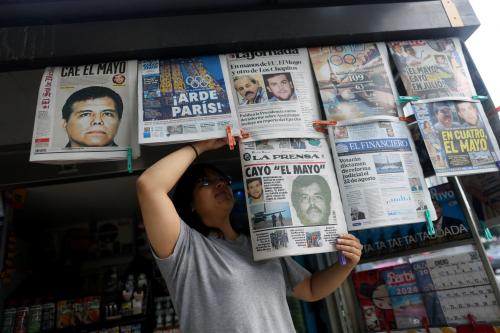It would be unrealistic to expect crime to continue dropping sharply as it did in the 1990s, but that is no reason to undermine the progress brought by successful policies. With recent FBI data showing crime on the rise, it is time to reconsider the massive de-funding of one of the most successful federal anti-crime measures of the 1990s: the U.S. Department of Justice’s Office of Community Policing Services (COPS) program. The program, authorized by the Violent Crime Control and Law Enforcement Act of 1994, provides grants to state and local police to hire additional officers and adopt aspects of “community policing.”
The COPS program distributed nearly $1 billion in hiring grants to state and local police in each fiscal year from 1995 to 1999. Yet the amount of COPS funding allocated to helping state and local departments hire more police has declined dramatically over the past several years. The funding allocated for this purpose in fiscal 2005 was just $5 million. COPS has been effective in putting more police officers on the street. The best available evidence suggests that more police lead to less crime. Thus, COPS appears to have contributed to the drop in crime observed in the 1990s.
Given that the costs of crime to American society are so large – perhaps as much as $2 trillion per year – even small percentage reductions in crime can reap very large benefits. Our calculations suggest restoring the $1.4 billion COPS budget that prevailed in fiscal 2000 is likely to generate a benefit to society valued from $6 billion to $12 billion. COPS appears to be one of the most cost-effective options available for fighting crime.
Policy Brief #158
Introduction
FBI statistics suggest that violent crime rates increased from 2004 to 2005, and continued to climb through at least the first half of 2006. The massive drop in violent crime witnessed in the 1990s, when homicide rates declined by nearly 45 percent, has stalled since the turn of the millennium (Figure 1). As the Washington Post noted in a front-page article in December 2006, “the historic drop in the U.S. crime rate has ended and is being reversed.”
It is in our view no coincidence that violent crime rates were declining during the 1990s when the number of police patrolling U.S. streets was on the rise (shown in Figure 1 by the number of police per 100,000 people), and that the crime drop has stalled as the number of police per capita has declined. The increase in police spending during the 1990s was driven in part by the federal government’s new COPS program, which distributed nearly $1 billion in hiring grants to state and local police in each fiscal year from 1995 to 1999. Yet the amount of COPS funding allocated to helping state and local departments hire more police has declined dramatically over the past several years; the total amount of funding allocated for this purpose in 2005 was equal to just $5 million (see: http://www.cops.usdoj.gov/mime/open.pdf?Item=1611).
A funding cut of 99.5 percent for police hiring under COPS would make sense if the program were ineffective or inefficient, but this is not the case. The best available research suggests that putting more police officers on urban streets is one of the most cost-effective ways to reduce crime.
COPS and Cops
Demonstrating the desirability of the COPS program requires that we establish a number of propositions. First, in order for the COPS program to reduce crime successfully in the United States, COPS hiring grants to state and local law enforcement agencies need to actually translate into more police officers on the street. This need not be the case, since as with any government program many things can go wrong. Money might be mismanaged or misspent. State and local police departments might be unable to recruit and train enough new police officers, particularly when the labor market is tight, as it was in the 1990s. Or jurisdictions that receive a grant from the federal government to hire more police might simply reduce their own financial contributions to the police department by the exact same amount.
Yet the best available research suggests that the COPS program was in fact successful in putting more police on the street. A recent report by the Government Accounting Office estimated that in 2000, the peak year of COPS hiring grants, the program funded around 17,000 sworn officers, equal to around 3 percent of the total number of sworn police officers across the country. A study by economists William Evans and Emily Owens at the University of Maryland suggests that state and local law enforcement agencies do reduce somewhat their own budgets for hiring in response to COPS grants, but that on average each extra 10 officers paid for by a COPS grant increases the size of the agency’s police force by seven officers. Accounting for the partially offsetting behavior by state and local government suggests that COPS increased the total number of police officers on the street in the peak year of 2000 by 11,900 officers, equal to around 2 percent of the total police force in the country that year.
COPS and Crime
The second proposition – that more police on the streets leads to lower crime – would appear to be obviously true. But substantial social science research at one point seemed to challenge this proposition. The skeptics concerning police effectiveness pointed out that the police very rarely arrest someone who is in the middle of committing a crime. Even the very best police departments require several minutes to respond to a 911 call for help – which is usually enough time for criminal perpetrators to flee the scene. And of course with many violent and property crimes the victims themselves are unable to report the crime to the police until after the crime has been completed. As President Clinton was advocating the need for 100,000 more cops on the street in 1994, one prominent academic skeptic on police effectiveness (David Bayley) wrote: “The police do not prevent crime. This is one of the best kept secrets of modern life. Experts know it, the police know it, but the public does not know it. Yet the police pretend that they are society’s best defense against crime and continually argue that if they are given more resources, especially personnel, they will be able to protect communities against crime. This is a myth.”
Despite the plausibility of the view that stepped-up policing might reduce crime by increasing the chances that an offender is successfully identified, arrested and punished after the fact, many criminologists were primed to endorse Bayley’s conclusion. These criminologists are skeptical about the whole idea of deterrence, noting that many would-be offenders are likely to be unaware of changes in policing intensity, while even those who are aware of stepped-up policing may be undeterred because they are drunk, destitute, enraged or deranged. Economists usually respond that more police spending can still reduce aggregate crime rates, even if many crime-prone people are unaware or unaffected by the policy change. All that is required is that at least some people at risk for committing crime realize and respond to the change in a local policing environment. Moreover, economists usually believe that criminals will be more responsive to changes in punishment certainty than severity, in part because people generally tend to be more focused on events that happen close in time rather than in the distant future. This implies that to the extent to which criminals can be deterred, stepped-up policing that increases the chances offenders are punished at all may be a more effective use of resources than handing out ever longer prison terms.
Progress in the science of econometrics has played an important role in providing a better answer to the important empirical question of the impact of police on crime. The key difficulty to generating good econometric estimates of this impact stems from the fact that police are not randomly distributed across municipalities in America. Big-city mayors are usually more worried about crime than their counterparts in charge of affluent suburban communities, and set their police budgets accordingly. But the fact that high-crime cities spend more on police per capita on average than do lower-crime jurisdictions does not mean that police cause crime, in the same way that the increased prevalence of sick people in doctor’s offices does not mean that modern medicine causes bad health outcomes. Even comparing how crime changes within a given jurisdiction when police spending goes up may be problematic, since additional resources are often devoted to police departments when crime rates are increasing.
Only recently have social scientists been able to make real headway in untangling this causal relationship, with the best available studies now suggesting that increasing the number of police on the streets will in fact reduce crime. One of the best of these studies is by University of Chicago economist Steven Levitt,, who examines what happens in cities that increase police spending for reasons unrelated to what else is going on with local crime trends, for example because of stronger public service unions. Levitt’s estimates suggest that each 10 percent increase in the size of the police force reduces violent crime by 4 percent and property crimes by 5 percent. The 2 percent jump in the number of police generated by COPS should reduce violent crimes by about 0.8 percent and property crimes by about 1 percent. Other studies that have followed Levitt’s strategy of seeking natural experiments to generate valid estimates of the effectiveness of police in reducing crime typically find qualitatively similar results.
Note that Levitt’s estimates reflect what happens to crime when cities put more police on the street and continue to deploy them in the usual way. Other research in criminology and economics suggests that the effectiveness of police resources might be enhanced further by targeting police attention at the highest-risk people or places, such as crime “hot spots” or gang members, or focused on the highest-cost parts of the crime problem, such as gun violence. These are the types of responses that the COPS Office promotes, and so the effects of increased police presence funded by the COPS program could in principle be somewhat larger than Levitt’s estimates might imply.
Several recent studies that attempt to directly evaluate the effects of the COPS program suggest that the COPS resources may indeed have been effectively targeted to generate such greater crime reductions. One of the best of these COPS evaluations is by University of Maryland economists William Evans and Emily Owens. Their estimates suggest the 2 percent increase in police under COPS led to a 2 percent decline in violent crime and a 0.5 percent reduction in property offenses. A recent study by the GAO yields qualitatively similar findings, suggesting that the COPS program contributed to a 2.5 percent decline in violent crime rates and a 1.3 percent decline in overall crime rates from 1993-2000.
These calculations imply that the COPS program is helpful but can account for no more than a small share of the massive proportional decline in violent crime rates observed throughout the United States during the 1990s. Other factors were even more important, including the increased spending on police that state and local governments undertook on their own, a massive increase in the nation’s incarceration rate, and the waning of the crack cocaine epidemic. The legalization of abortion in the early 1970s may have also contributed to the crime drop of the 1990s by reducing the share of adolescents and young adults who were brought up in disadvantaged household environments. Other politically controversial public policies, such as new gun control measures, liberalized gun-carrying laws, and increased application of the death penalty, do not appear to have contributed to the crime drop.
In any case, the right standard for judging whether COPS is a success is not whether the program can account for a “large” share of the crime drop in the 1990s. The key issue instead is whether the independent effects of the COPS program to reduce crime is large enough to justify the program’s budget. We turn to this third point next.



